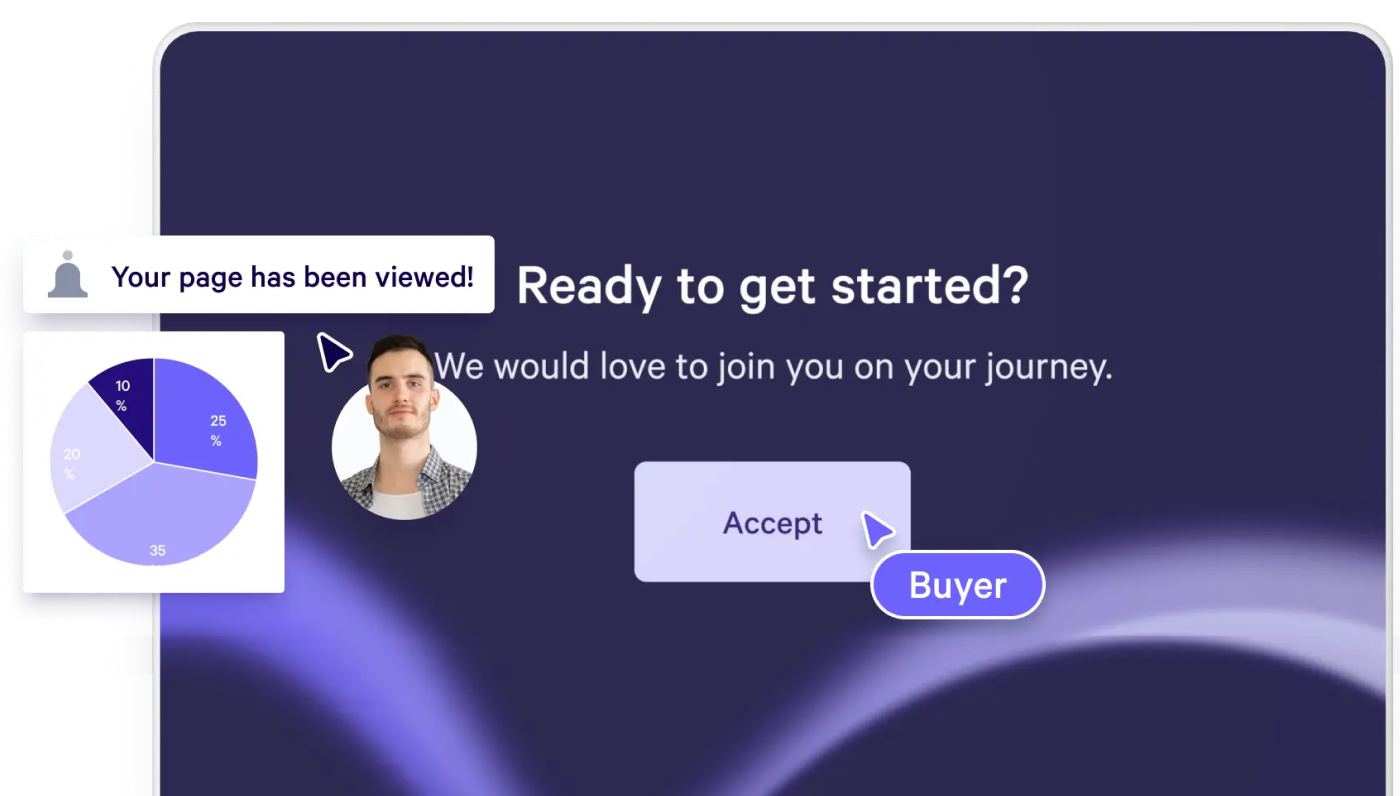
Crafting an HR consulting proposal that strikes the right chord with potential clients can feel like trying to solve a puzzle without all the pieces. Its importance only ratchets up the pressure. After all, it's not just any old document; it's your golden ticket to winning over new business and establishing credibility in a highly competitive landscape.
So, where do you even start?
How do you showcase your expertise without sounding boastful?
How do you tailor your sales proposal to meet the specific needs of each potential client while also making it scalable?
These are the challenges we understand all too well, and they are what we are here to unravel.
Through this guide, we'll break down the process into digestible, actionable steps, ensuring that by the end, you'll have a blueprint for crafting compelling HR consulting proposals and the confidence to pitch your services like a pro.
Key takeaways
- An HR consulting proposal is a strategic tool to showcase expertise and address client's specific HR challenges.
- Crafting a compelling proposal involves understanding client's needs, defining objectives, outlining methodology, and showcasing expertise.
- Transparency about costs and timeframes in the proposal builds trust and sets clear expectations.
- Including case studies or testimonials in the proposal can boost confidence in your services.
- A clear call-to-action at the end of the proposal makes it easy for the client to move forward.
What is an HR consulting proposal?
A HR consulting proposal is a detailed document that outlines what HR consulting services you offer, how you plan to implement them, and the benefits the client will receive. Like a finely-tailored suit, it must fit the client's needs perfectly to be considered.
A HR consulting proposal isn't just a formality; it's a strategic tool. It's your chance to stand out from the competition, showcase your expertise, and demonstrate how you can solve the client's specific HR challenges. Whether improving employee engagement, restructuring the organization, or implementing a new HR technology, your proposal is the first step towards a fruitful partnership.
But here's the thing – writing a compelling HR consulting proposal is an art. It's not just about listing services; it's about crafting a narrative that resonates with the client, addressing their pain points, and presenting a vision for a better future. It's about persuasion, clarity, and value.
Steps to write an HR consulting proposal: Key elements to include
So, how do you write a proposal that gets you noticed, appreciated, and, most importantly, hired? These are the steps you need to take along with the key elements you need to include:
Step #1: Understand the client’s needs
The first step requires a little detective work. You need to understand your client's business, their industry, and specifically, their HR challenges. This understanding forms the foundation of your proposal. Ask questions, listen actively, and dig deep. Only by truly understanding their pain points can you tailor your proposal to meet their unique needs.
Step #2: Define your objectives and scope
Here’s where you get specific. What exactly will you help the client achieve? Will you improve their recruitment process, enhance employee engagement, or perhaps streamline their performance management system? Clearly define your engagement's objectives and outline your services' scope. This clarity helps set expectations, build client trust and establishes a clear path forward.
Step #3: Outline your methodology
Now, explain how you plan to achieve the objectives you’ve set out. This is your methodology and your game plan. Detailing your approach, whether through one-on-one interviews, workshops, or data analysis, shows the client you have a structured process in place. It's like showing them the map of the journey you plan to take them on.
Step #4: Showcase your expertise and differentiators
Why should the client choose you over someone else? This is your moment to shine. Highlight your previous client successes, your unique approach to HR consulting, and the value you bring to the table. This could be your proprietary methodologies, your extensive experience in their industry, or your innovative solutions to common HR problems.
Step #5: Provide a detailed timeline and budget
Break down your proposal into phases and associate each with a timeline and budget. Being transparent about costs and timeframes builds trust with the client from the get-go. It also helps the client understand the investment required and what they can expect at each stage of the project.
Step #6: Include case studies or testimonials
Nothing builds confidence like proof of client success. To demonstrate your track record, include brief case studies or testimonials from past clients. The more relevant to the client's pain points, the better.
Step #7: Outline their next steps
Conclude your proposal by clearly stating the next steps. Should the client set up a meeting to discuss the proposal further? Is there a deadline for acceptance? Providing a clear call-to-action makes it easy for the client to move forward.
Example of an HR consulting proposal template
That was the theory, and now we’ll show you how it looks in practice with Qwilr’s HR consulting proposal template.
Of course, the main benefit of using a proposal template is the time savings, but ours goes a step further. Its sleek, multi-media capabilities let you populate your proposal with graphs, slideshows, and videos that grab attention and really bring it to life. All of this is easily customizable for both your brand and your prospective client to enhance the sales process and client experience.
Here is what we include:
Cover Page
- Title: HR Consulting Proposal for [Client Company Name]
- Date: [Submission Date]
- Prepared by: [Your Name/Your Company]
A cover page might seem like a small detail but think of it as the book cover for your story.
Table of Contents:
- Executive Summary
- Understanding Your Needs
- Objectives and Scope
- Our Methodology
- Why Us? Our Expertise and Differentiators
- Project Timeline and Budget
- Case Studies/Testimonials
- Terms and Conditions
- Next Steps
- Contact Information
A table of contents organizes your proposal and makes it easy for the client to navigate.
Executive Summary
This is your elevator pitch. Concisely and compellingly, summarize how you will address the client's HR challenges and the outcomes you'll achieve. Make them feel understood and excited about the potential for transformation.
Understanding Your Needs
Reflect on the client's situation as you understand it. This shows empathy and reassurance that you're on the same page. It's like saying, "I see you, I hear you, and I'm here to help." This will help build a relationship with the client.
Objectives and Scope
Clearly outline what you aim to achieve and the services you'll provide. This section is about painting a picture of the future and showing the path to get there.
Our Methodology
Describe your approach and how you'll tackle the project. This is where you show off your process and how it sets you apart.
Why Us? Our Expertise and Differentiators
Highlight your credentials, experience, and what makes you unique. This is your chance to shine and show why you're the best choice for them.
Project Timeline and Budget
Lay out the timeline, milestones, and investment required. Transparency here builds trust and sets realistic expectations.
Case Studies and Testimonials
Include real-life success stories or client testimonials that prove your ability to deliver. It’s the proof in the pudding, the evidence that your solutions work in the real world.
Terms and Conditions
Outline the legal and contractual aspects of the proposal. This might not be the most thrilling part, but it’s crucial for setting clear terms of engagement.
Next Steps
Guide the client on how to proceed. Make it easy for them to say yes, with clear instructions on the acceptance process.
Contact Information
Provide your contact details for any questions or to discuss the proposal further.
Final Thoughts
Remember that the essence of a great HR consulting proposal lies not just in the structure or content but in the intent behind it—the genuine desire to positively impact your client's world. With every proposal you craft, you're not just offering services; you're offering hope, solutions, and the promise of a brighter future.
We'll end on that sunny note. We hope this guide has de-mystified the process for you. If you’d like another helping hand, why not try Qwilr’s HR Consulting Proposal Template? It not only saves you time making the proposal, but it also ensures a more enjoyable experience for your clients when they read it. You can try Qwilr's proposal software free for 14 days.
About the author

Brendan Connaughton|Head of Growth Marketing
Brendan heads up growth marketing and demand generation at Qwilr, overseeing performance marketing, SEO, and lifecycle initiatives. Brendan has been instrumental in developing go-to-market functions for a number of high-growth startups and challenger brands.
Frequently asked questions
The best format is one that's clear, engaging, and straightforward. Start with a bang (executive summary), delve into the heart of the matter (client's needs and your proposed solutions), showcase your magic tricks (methodology), and seal the deal with why you’re the right choice. A sprinkle of success stories and a clear call to action wrap it up nicely. It's about making your proposal not just read but felt.
Transparency is your best friend here. Break down your pricing in a digestible way, highlighting the value behind each cost. This will reassure clients that there are no hidden surprises.
Absolutely! Incorporating elements like interactive links, videos, or even an engaging slideshow can transform your proposal from a document into an experience. Grabbing, then holding, attention can be the key to a successful proposal, and digital elements are one of the best ways to do this.
Use persuasive storytelling, include compelling case studies, and don’t shy away from showcasing your unique approach. Think of it as your proposal wearing a bright red jacket in a sea of grey suits—it’s going to get noticed.
Avoid the cookie-cutter approach—generic proposals invariably get the attention they deserve. Overloading with jargon is another no-go; keep the language clear and accessible. And remember, a proposal without a clear next step is like a story without an ending—unsatisfying. Ensure your client knows exactly what to do when they're as excited as you are by your proposal.




